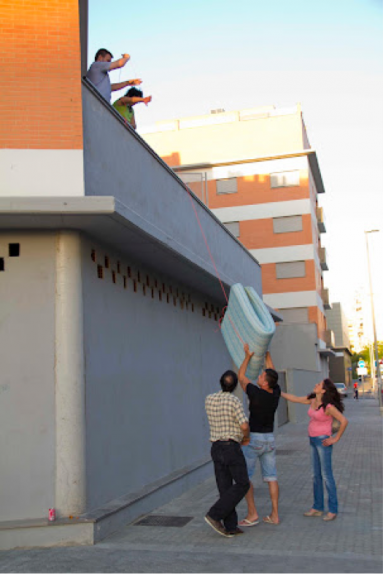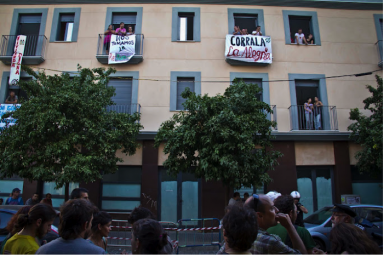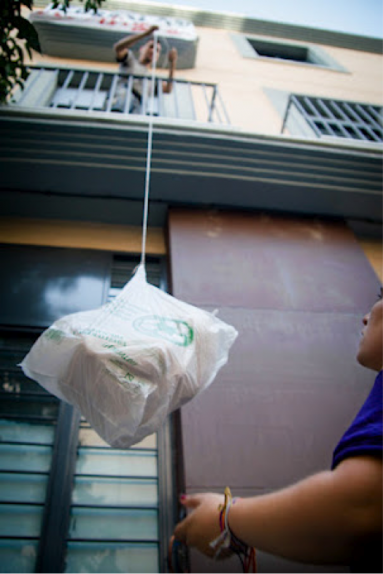Long before the Occupy movement, there was the movimiento okupa. In Spain, the word okupa (from the verb ocupar)
The okupa as political project emerged in Spain after the death of Franco in 1975 and exploded in the punk scene and the countercultural movida of the 1980s. While the gravitational center of the okupa movement in Spain has long been the north—especially Barcelona and Euskadi (the Basque Country), followed by Madrid—recently the southernmost region of Andalusia has entered the spotlight.
Last month, hundreds of members of a fieldworkers’ union called the Sindicato Andaluz de Trabajadores (SAT) organized a march through the Andalusian countryside. At one stop, they took over the uncultivated, vacant estate of the Duke of Segorbe, some 60 miles east of Sevilla. It was a symbolic occupation, and after a dip in the pool out behind the palace the workers continued their march the next day, but other land occupations in the region have in fact been transformed into working farms, providing jobs and food for an increasingly precarious population.
* * *

Four months ago, a group of community members and activists associated with the 15-M or indignados movement took over an abandoned apartment building in the working class neighborhood called La Macarena. Today, more than 100 people are living in its 36 apartments. Elena Contreras, a member of the Corrala Utopía’s media team, explained the building’s shady history. The piece of land on which it was built was originally public, but the city government sold it to a developer, Maexpa, which proceeded to sell it twice more to Maexpa-owned front companies in order to pump up the property value. (Now in bankruptcy and facing multiple corruption charges, Maexpa is no longer active in Spain but continues to operate in countries like Morocco and Angola.) Meant to be upscale, the building turned out a structural disaster. The windows don’t close, the plaster is crumbling, and the shoddy plumbing caused leaks inside the walls. Many had to be torn out and replaced by the occupiers. “There’s a pool on the roof,” Elena said. “But we can’t fill it up because the building isn’t strong enough to bear the weight of the water.”
About two weeks into the occupation, the city cut off the electricity and water. At least it helped with the leaks, offered Elena.
The Corrala Utopía is not exactly a squat. Its residents don’t call it an okupa or even an “ocupa con c.” Instead they’ve taken to calling it a realojo, a “re-housing,” as opposed to a desalojo, a “de-housing” or eviction, like when the police come to kick you out of your foreclosed house. I suspect this is mostly a rhetorical strategy, designed to emphasize the fact that the people involved aren’t punks or anarchists or stereotypical okupas but just “regular people” who’ve been hit hard by the crisis.
“Obviously it has to do in part with basic needs,” said Elena. “There are residents who’ve been living on the streets and have come here because they had no other way to get a roof over their heads. But at the same time we wanted people to see that this problem exists so it can be fixed. And anyway,” she continued, “it’s outrageous that there are so many empty apartments when there’s so many people on the streets.”
* * *

A few weeks ago, I got a text message from Elena about another housing action that afternoon.
For someone who has experienced the police response to building occupations in the United States, the ease with which buildings are taken here is almost laughable. After most of the Occupy movement’s encampments were forcibly evicted from public parks and plazas last fall and temperatures started to drop, empty buildings seemed to offer a logical and necessary next target. And buildings were in fact occupied, from California to the Midwest and the East Coast. But in every case, it took at most a day or two for police to evict the occupiers.
In Oakland, for example, after a month of careful planning and outreach, on January 28 “Move-In Day,” about 2,000 people came together for the explicitly illegal purpose of occupying an empty building and transforming it into Occupy Oakland’s new base of operations. Security culture required that the specific building be kept as secret as possible in order to stay ahead of the cops, so a tactical team was put in charge of scouting and selecting a building. Under a massive banner reading “If it’s vacant / TAKE IT,” people marched from Oscar Grant Plaza carrying cleaning supplies, rugs, chairs, plants, and lots of food with which to set up the new space. But the city had deployed the riot cops in full force, and, with tear gas, flash-bang grenades, and rubber bullets, prevented the march from even reaching the targeted building, the vast and empty Kaiser Convention Center. Later that night, the cops would kettle and illegally arrest over 400 people.
At the occupation of the Corrala de Vecinas “La Alegría,” the police response was almost exactly the opposite. It took the cops a full hour to even appear on the scene, despite the fact that the police station is only a few blocks away. When they finally did arrive, there were only three of them, and they pulled up on little scooters. Later, a handful of riot cops did show up in a van, but they never came close to putting on their helmets or drawing their batons. There was a single, brief moment of tension—a second police van suddenly appeared and we quickly moved across the street to stand in front of the building and block the doorway. I kept expecting the people around me to start linking arms. But the officer in charge assured the negotiation team, “We didn’t come here to kick anybody out.” An agreement was quickly reached—we would move back to the opposite side of the street, leaving the sidewalk open, and in exchange the police would leave except for four officers who would withdraw to the corner of the block to observe. After the majority of the cops took off, community members started showing up with supplies, which the occupiers hoisted up to the second floor window on a rope with a metal clamp attached to the bottom. Cold bottled water, sandwiches, a tank of propane gas, a little later a mattress and a large wooden chair. The four cops stood on the opposite corner, smoking and watching.
* * *

Listening to the communiqué being read by an occupier over a bullhorn from the third-floor balcony of the Corrala Alegría, I noticed an interesting tension between the “reformist” rhetoric and the direct action practice of these okupas. The communiqué appealed to Article 47 of the Spanish Constitution which affirms that housing is a “fundamental right,” and called on the authorities “to find a solution to the housing problem.” It also declared the occupiers’ willingness to pay rent “according to our level of income” and requested public mediation between the various parties involved to help generate a more official arrangement. The shift from okupa to realojo seems to carry with it a willingness to negotiate with the authorities, to legalize or formalize the occupation.
Despite the relatively permissive response of the authorities to building occupations, okupas are not entirely secure. In addition to practical matters such as the utilities being cut off as with the Corrala Utopía, sooner or later they will face the very real prospect of eviction. As the Oficina de Okupación de Madrid notes in its useful okupa manual, it can take months or even years to go through the long, bureaucratic process of getting a judge to rule on the matter and finally issue an eviction order. But it will most likely happen at some point. Even in Spain, the history of the okupa movement is in part a history of evictions.
In 2010, at the height of the financial crisis and foreclosure epidemic in Spain, the government made a number of changes to the criminal code. One was of particular concern for the okupas. Article 245, which deals with the crime of usurpación (something like criminal trespass), was modified to increase the penalty from a stiff fine to a jail sentence of one to two years. As the new criminal code went into effect, the government also modified the law of civil procedure to accelerate the process of obtaining an eviction order. In many ways, these changes constitute a greater threat to okupas than the harsher criminal sentences, as property owners increasingly turn to civil courts for a quick decision.
Recently, some participants in the okupa movement have developed what is an admittedly controversial periodization, distinguishing between “first” and “second generation” okupas. According to this formulation, the earliest okupas were groundbreaking interventions in and against the hostile space of the early neoliberal city. But there was a “dark side” to these spaces: their strong collective practices eventually rendered an insular milieu based on rigid political, identity, or aesthetic affiliations (punk, anarchist, nihilist, etc.) that closed them off from the surrounding communities and the social bases of struggle. At the same time, the constant risk of eviction generated a constant, draining tension that circumscribed the kinds of actions they were willing and able to take. “Second generation” okupas, then, see themselves as engaging in a new kind of process, opening up the okupa form to diverse social actors and using dialogue with local authorities to stabilize the occupied space. As a result, the okupa is excised from the social center—the CSOA has become the CSA, and occupation is no longer seen as essential to the political project.
This is, for obvious reasons, a contentions distinction. Many criticize the “second generation” for selling out, for becoming yet another non-threatening provider of social services that, in exchange for their own legitimation, reciprocally legitimize the state and facilitate its austerity regime.
What’s interesting about this periodization is that, although these “second generation” theorists, heavily influenced by the thought of autonomist Marxists like Antonio Negri, are attentive to the increasingly precarious conditions of labor and life in late capitalism, they at times seem to bypass the ways that the okupa could be, and in fact is being, used to satisfy the acute needs of the increasingly precarious population—the unemployed, the underemployed, the foreclosed on. In these writings, the social center appears first and foremost as a site of political organizing and autonomous cultural/knowledge production. This is important work, but it doesn’t quite capture the shift that is taking place in the okupa movement in the recently occupied Corralas in Sevilla or, for that matter, the SAT’s occupied farms and supermarket expropriations.
Before 15-M, there was a chant that was commonly used when okupas were threatened with eviction: ¡Un desalojo, otra okupación! If you evict us, we’ll just occupy another building. At the rally outside the newly occupied Corrala Alegría, there was a new chant: ¡Un desahucio, una okupación! For every foreclosure that you enforce against us, we will fill an empty building with people. The change is small but significant. While both slogans take as their point of departure the ruined landscape of the city in crisis, in the first case what is at stake is the reproduction of the okupa itself. In the second, however, the shift in emphasis from eviction of an okupa to foreclosure of a resident speaks to the reproduction of precarious communities, to a new strategy of people simply and straightforwardly seizing what they need to survive while simultaneously attacking the system that ensures their precarity. In this way, the Corralas are linked to the SAT’s supermarket actions by more than the fact that they received some of the expropriated food—they designate, if not another “generation,” then certainly a reinvigorated okupa formation, primed for austerity capitalism.
* * *
Not much usually happens in Sevilla in August, when the temperature consistently rises above 100 degrees and many residents head for the coast to escape the heat. But austerity doesn’t wait around. On September 1, the most recent austerity measure imposed by the Spanish government, a 3 percent hike in the sales tax, went into effect. If recent actions in Sevilla are any sign, this could mark the beginning of a new wave of okupas, the front line in the struggle against austerity.
(All photos come from the blogs of the Corrala Utopía and the Corrala Alegría.)

